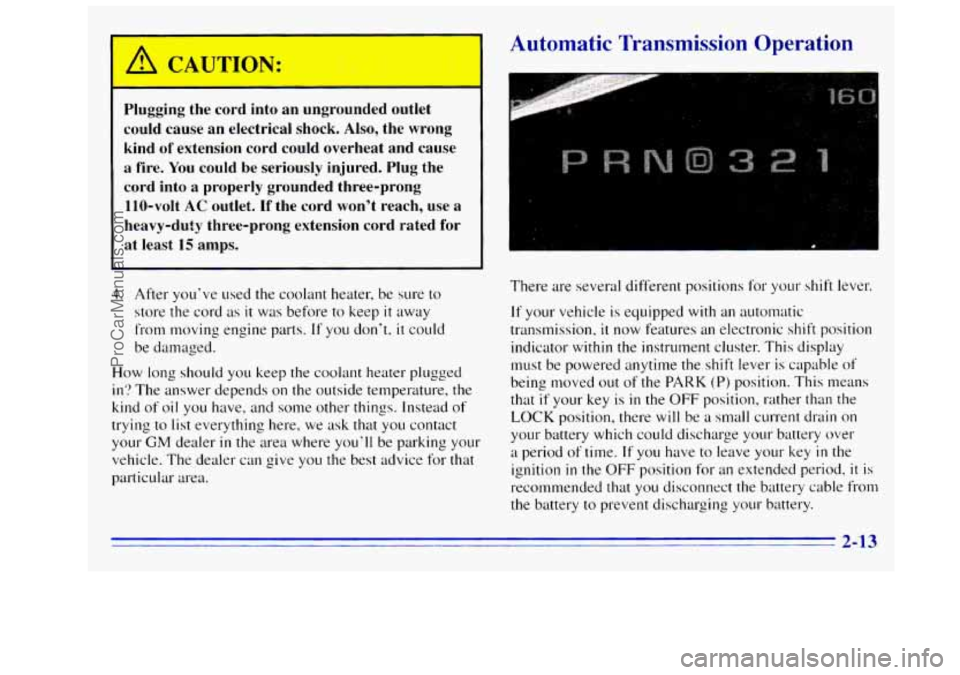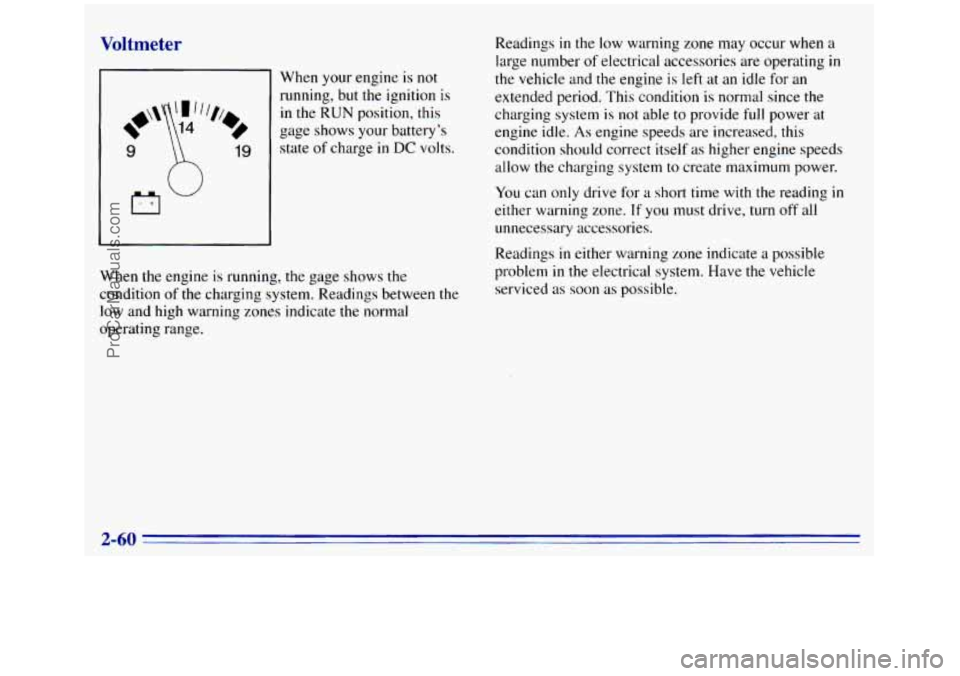1996 GMC SIERRA charging
[x] Cancel search: chargingPage 7 of 404

Vehicle Symbols
These are some of the symbols you may find on your vehicle.
For example,
these symbols
are used on an
original battery:
POSSIBLE A
CAUTION
INJURY
PROTECT EYES BY
SHIELDING
CAUSTIC
ACID COULD BATTERY
CAUSE
BURNS
These symbols
are important
for you and
your passengers
whenever your
vehicle is
driven:
DOOR LOCK
UNLOCK
FASTEN SEAT
BELTS
These symbols
have
to do with
your lights:
SIGNALS e e3
TURN
WARNING
A
HAZARD
FLASHER
These symbols are
on some of
your controls:
WINDSHIELD
DEFROSTER
These symbols are used on
warning and
indicator lights:
COOLANT
TEMP
-
CHARGING I-1
BAllERY
SYSTEM
BRAKE
(0)
Here are some
other symbols
you may see:
FUSE
LIGHTER
AVOID
SPARKS
OR
FLAMES
SPARK
OR ,\I/,
COULD FLAME
EXPLODE BATTERY POWER
WINDOW RUNNING
0
DAYTIME -
LAMPS '*'
FOG LAMPS # 0
VENTILATING
FAN
1
-3
COOLANT a
ENGINE OIL e,
PRESSURE HORN
)tr
SPEAKER v
FUEL B
V
ProCarManuals.com
Page 75 of 404

..
Plugging the cord into an ungrounded outlet
could cause an electrical shock. Also, the wrong
kind of extension cord could overheat and cause
a fire.
You could be seriously injured. Plug the
cord into a properly grounded three-prong 110-volt
AC outlet. If the cord won't reach, use a
heavy-duty three-prong extension cord rated for
at least
15 amps.
3. After you've used the coolant heater, be sure to
store
the cord as it was before to keep it away
from moving engine parts.
If you don't. it could
be damaged.
How long should you keep the coolant heater plugged
in'? The answer depends on the outside temperature, the
kind of oil you have, and some other things. Instead of
trying to list everything here, we ask that you contact
your GM dealer in the area where you'll be parking your
vehicle. The dea1e.r can give
you the best advice for that
particular area.
Automatic Transmission Operation
There are several different positions for your- shift lever.
If your vehicle is equipped with an automatic
transmission,
it now features an electronic shift position
indicator
within the instrument cluster. This display
must be powered anytime the shift lever is capable
of
being moved out of the PARK (P) position. This means
that
if your key is in the OFF position, rather than the
LOCK position, there will be a small current drain on
your battery which could discharge your battery over
a period of time. If you have to leave your key in the
ignition
in the OFF position for an extended period, it is
recommended that you disconnect the battery cable from
the battery
to prevent discharging your battery.
ProCarManuals.com
Page 121 of 404

Air Bag Readiness Light
There is an air bag readiness light on the instrument
panel, which shows AIR BAG. The system checks the
air bag’s electrical system for malfunctions. The light
tells
you if there is an electrical problem. The system
check includes the air bag sensors, the air bag module,
the wiring and the diagnostic module. For more
information
on the air bag system, see “Air Bag” in
the Index.
AIR
BAG
You will see this light flash
for a few seconds when you
turn your ignition
to RUN
or START. Then the light
should go out. This means
the system is ready.
Charging System Indicator Light
If the air bag readiness light doesn’t come on when you
start your vehicle, or stays on, or comes on when you
are driving, your air bag system may not work properly.
Have your vehicle serviced right away. This
light should come
on
briefly when you turn on the
ignition, before starting the
engine, as
a check to show
you it is working.
After the engine starts,
the light should go out. If it stays
on or comes on while
you are driving, you may have a
problem with your charging system. It could indicate a
problem with the alternator drive belt,
or some other
charging system problem. Have
it checked right away.
Driving while this light is on could drain your battery.
If
you must drive a short distance with this light on, it
helps to turn off all your accessories, such
as the radio
and air conditioner.
2-59
ProCarManuals.com
Page 122 of 404

Voltmeter
I When your engine is not
running, but the ignition is
in the RUN position, this
gage shows your battery’s
9 19 state of charge in DC volts.
n
When the engine is running, the gage shows the
condition
of the charging system. Readings between the
low and high warning zones indicate the normal
operating range. Readings
in the low warning zone
may occur when a
large number of electrical accessories are operating
in
the vehicle and the engine is left at an idle for an
extended period. This condition
is normal since the
charging system
is not able to provide full power at
engine idle.
As engine speeds are increased, this
condition should correct itself as higher engine speeds
allow
the charging system to create maximum power.
You can only drive for a short time
with the reading in
either warning zone. If you must drive, turn off all
unnecessary accessories.
Readings
in either warning zone indicate a possible
problem
in the electrical system. Have the vehicle
serviced
as soon as possible.
2-60
ProCarManuals.com
Page 396 of 404

Labels Certification
................................. 4-42
CertificatiodTire
............................. 4-42
Service Parts Identification
..................... 6-67
Vehicle Identification Number
................... 6-67
Lalnps
........................................ 2-39
Cargo
...................................... 2-43
Dome
...................................... 2-42
Interior
..................................... 2-42
On Reminder ................................ 2-39
UnderhoodReel
.............................. 2-41
Latches. Seatback
................................ 1-5
Leaving Your Vehicle ............................. 2-5
Leaving Your Vehicle
with the Engine Running ....... 2-28
Lighter
....................................... 2-52
Lights Air Bag Readiness
....................... 1-22. 2-59
Anti-Lock Brake System Warning
............ 2.62. 4-6
Brake System Warning
......................... 2-61
Charging System
............................. 2-59
CheckGages
................................ 2-67
Daytime Running Lamps Indicator
............... 2-67
Safety Belt Reminder
...................... 1-9.2-58
Service Engine Soon
.......................... 2-63
Shift
.................................. 2-20. 2-66
Loading Information, Truck-Camper
............... 4-44
Loading Your Vehicle
........................... 4-42
Lockoutswitch
................................ 2-32
Locks
Cylinders ................................... 7-43
Door
........................................ 2-4 Key Lock
Cylinders Service
.................... 7-43
PowerDoor
.................................. 2-5
Steering Column Lock Check
................... 7-45
Lubricants
and Fluids ............................ 7-48
Lubrication Service. Body
........................ 7-43
Lumbar Controls
................................ 1-2
Maintenance. Normal Replacement Parts
........... 6-75
Maintenance Record
............................ 7-51
Maintenance Schedule
............................ 7-1
Long Trip/Highway Definition
................... 7-5
Long Trip/Highway Intervals
..................... 7-5
Owner Checks and Services
..................... 7-42
Periodic Maintenance Inspections
................ 7-46
Recommended Fluids and Lubricants
............. 7-48
Scheduled Maintenance Services
.................. 7-3
Short Trip/City Definition
....................... 7-4
Short Trip/City Intervals ........................ 7-4
Maintenance. Underbody
......................... 6-65
Maintenance When Trailer Towing ................. 4-59
Malfunction Indicator Lamp
...................... 2-63
Manual Front Seat
............................... 1-1
Manual Mirror ................................. 2-45
Manual Transmission Check
...................................... 7-43
Fluid
....................................... 6-22
Shifting
................................ 2-17. 2-18
Starting Your Engine .......................... 2-11
Manual Windows
............................... 2-31
Memo Pad Holder
.............................. 2-49
Methanol
...................................... 6-3
9-6
ProCarManuals.com